Meeting Review: Advances in Microcolumn and Related Separation Technologies
The Column
The first meeting in The Chromatographic Society’s diamond anniversary year brought together world-renowned speakers alongside past presidents of the Society and delegates from academia, industry, and scientific instrument and technology companies at the Institute of Engineering and Technology in central London. The presentations included discussions on gas chromatography (GC), liquid chromatography (LC), capillary electrochromatography (CEC), and supercritical fluid chromatography (SFC) from both academic and industrial perspectives - providing valuable insight into contemporary trends in chromatographic techniques.
Photo Credit: vladimir zakharov/Getty Images

Paul Ferguson1 and W. John Lough1,2,1The Chromatographic Society, UK, 2University of Sunderland, Sunderland, UK.
The first meeting in The Chromatographic Society’s diamond anniversary year brought together world-renowned speakers alongside past presidents of the Society and delegates from academia, industry, and scientific instrument and technology companies at the Institute of Engineering and Technology in central London. The presentations included discussions on gas chromatography (GC), liquid chromatography (LC), capillary electrochromatography (CEC), and supercritical fluid chromatography (SFC) from both academic and industrial perspectives - providing valuable insight into contemporary trends in chromatographic techniques.
The Chromatographic Society’s Advances in Microcolumn and Related Separation Technologies meeting was held on the 22 March 2016 at the Institute of Engineering and Technology (IET) overlooking the River Thames in Savoy Place, London, UK. There were over 130 attendees registered for the meeting and 14 vendors (including the principal meeting sponsors Agilent, Shimadzu, and Waters) presenting the latest from their product portfolios (see Table 1 for all vendors present at the meeting).
Paul Ferguson (President, The Chromatographic Society) opened the meeting by explaining that the IET has a special place in the history of The Chromatographic Society because this was the venue for the first meeting held on 31 May–1 June in 1956. That meeting was organized primarily by Denis Desty of BP, and from that gathering the Gas Chromatography Discussion Group arose, and from this - its eventual successor today - The Chromatographic Society. Paul congratulated the meeting organizers (Alan Handley, Peter Clayton, and Heather Linnell) on the lecture programme and organization and provided delegates with some humorous reflections of the 1956 meeting from past chairman of the Society (and Martin Medal winner) Ted Adlard, who is one of only three UK attendees still alive from that historic meeting.
The lecture sessions were chaired by a number of past presidents of the Society with Derek Stevenson (University of Surrey, Chromatographic Society President 1996–1998) presiding over the first session on liquid chromatography (LC). The first presentation was given by Peter Schoenmakers (University of Amsterdam, Netherlands) on “Modern Advances in HPLC”. His presentation reflected on the history of liquid chromatography and, in the spirit of one of the themes of the meeting, he gave his views on the top 10 developments in LC over the last 60 years and the unfulfilled promises. Peter’s top 10 were:
- Progression from 40-µm pellicular materials to 10-µm totally porous particles
- Chemically bonded stationary phases
- Size-exclusion chromatography in high performance liquid chromatography (HPLC) systems
- Gradient elution
- Ion chromatography
- Successful LC coupled to mass spectrometry (LC–MS)
- Chiral selectivity
- Finger-tight (polymeric) connections
- Progression to ultrahigh-pressure LC (UHPLC)
- Comprehensive two-dimensional (2D) LC
Commenting on how difficult the choice had been, he noted that he had omitted capillary electrochromatography (CEC), supercritical fluid chromatography (SFC), chip-based separations, monolithic columns, and “spatial chromatography”.
He also deliberated on European funding of analytical chemistry and the high investment on nuclear magnetic resonance (NMR) and high-resolution (HR)MS. Given the achievements in these fields, he mused, “Why do chromatography?” He noted that ion suppression can still be a major issue in the use of MS and joked that, at the very least, LC can be viewed as “the best-ever sample prep technique!”
For the main part of his talk though, he focused principally on multidimensional chromatography based on the peak capacity theory of Davis and Giddings (1) and the application of this theory to complex mixtures, such as peptides where coelution of multiple peaks is common. Using reversed-phase LC of a tryptic digest of S. aneidensis, which took 610 h to analyze as an example, Peter used kinetic plots to discuss the limitations of peak capacity for one-dimensional (1D) LC. He explained the increase in peak capacity, n, that could be obtained through using 2DâLC (2Dn = 1n x 2n, provided the selectivities of the two dimensions are orthogonal). In highlighting the advantages of 2D-LC, Peter also drew attention to some of the potential pitfalls. Chief amongst these was what he characterized as the “dilution dragon”! However, he felt that his group had satisfactorily addressed the problem of sample dilution during elution in the first dimension and transfer into the second dimension by using what he described as “active modulation”, whereby fractions are trapped on a stationary phase, de-salted, and eluted off in a much narrower band.
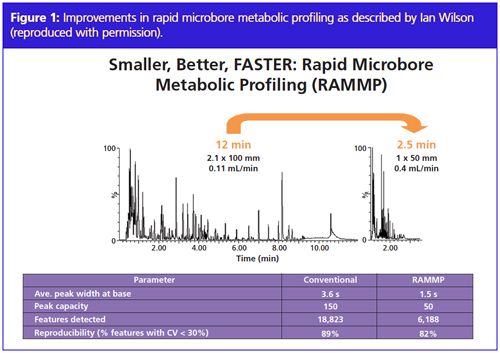
Peter’s group are now investigating highâresolution separations using 3D-LC (2), which, to all intents and purposes, would be 4D when using mass spectral resolution. This major endeavour, which goes under the acronym STAMP (Separation Techniques for A Million Peaks), has recently received significant European funding.
The second speaker in this session was Ian Wilson (Imperial College London, UK) who discussed his group’s work on metabolomics in his presentation “Approaches for Complex HPLC Separations”. Ian has a rich history with the Society as a previous Jubilee Medal awardee, the 2016 Martin Medal recipient, and a past President (1988–1990 and 2000–2001) of the Society. Ian began his presentation by reflecting on the remarkable progress that has been observed in the field of chromatography for biomarker discovery in the last century. He noted the development of 2D paper chromatography used by Dent for the analysis of amino acids in 1947 and GC–MS used for the identification of >1000 disease markers in urine in the Oak Ridge analyzer project.
The field of metabolomics requires extensive use of UHPLC (in both reversed phase and hydrophilic interaction liquid chromatography [HILIC] modes for retention of polar analytes [3]) coupled to MS detection for peak identification and quantification, but there are significant suppression effects that mask peaks as a result of the nature of the biosamples. The example highlighted by Ian involved the impact of ethanol (from alcohol), which forms ethyl linoleate and migrates into cells, which in turn reacts with a variety of lipids to produce characteristic biomarkers in rodent subjects. He described the efforts of his team in making the chromatography they use more rugged and robust. They developed a rapid microbore metabolic profiling (RAMMP) approach using amino acid derivatization and based it on scaling a conventional reversedâphase UHPLC–MS method from 2.1 × 100 mm columns to 1.0 × 50 mm columns, thereby increasing the linear velocity of the solvent, and decreasing the gradient time to provide an analysis time of 2.5 min per sample. A comparison of the conventional UHPLC–MS and rapid gradient approaches provided peak capacities of 150 and 50 respectively, with the conventional method detecting approximately 19,000 features compared to nearly 6000 found using the rapid method. Despite the reduced peak capacity and the reduction in ions detected, the RAMMP method was able to achieve similar levels of group discrimination as conventional UHPLC–MS when applied to the analysis of urine samples in large batches.
In questions taken after the presentation, Pat Sandra remarked that the development of reliable and reproducible 1.0 mm i.d. columns should be added to Peter Schoenmakers’s list because he felt this was a major advancement in the field of chromatography.
Next to present was David McCalley (University of the West of England, UK) who presented on “Core–Shell, UltraâSmall Particles, Monoliths, and Other Support Materials in HPLC”. He opened his presentation by reflecting on the efficiency loss on 4.6- and 2.1-mm columns packed with 1.7-µm particles, and how the absolute loss of efficiency was less on the 4.6 mm column than the 2.1 mm one with increasing isocratic retention. The loss was more dramatic on a 5-cm column than a 10-cm equivalent. He also discussed the impact of pressure on analyte retention and selectivity. He illustrated how retention of insulin could be increased from 8× to 30× by increasing the back pressure on a restrictor from 100 bar to 1100 bar. David then went on to describe the methods to fabricate solid-core particles through:
- Layer-on-layer
- Coacervation (as pioneered by Jack Kirkland [4])
- Sphere-on-sphere (as developed by Peter Myers; has shown utility for analysis of proteins [low diffusion])
He described why core–shell materials provide such high chromatographic efficiencies. There is a decrease in all three terms of the van Deemter equation. The reduction in the A term is due to the narrow particle size distribution; the reduction in the B term reflects the lower amount of mobile phase in the column as a result of improved packing, which leads to lower molecular diffusion; but the decrease in the C (mass-transfer) term is only realized for large molecules. David also challenged the prevailing notion regarding the overloading of solid-phase particles compared to fully porous particles. Based on sphere volumes, solid core particles are calculated to have 75% of the volume of fully porous particles (of the same nominal particle diameter) and are therefore not that easily overloaded.
David also described the higher efficiencies that can be generated using laser etched pillar arrays (5), or monolithic columns (which do not perform as well as solid-core particles except potentially those with long beds for high resolution nucleotide analysis). He concluded by stating that he did not understand why analysts still used fully porous particles.
The speaker programme also included presentations from the gold sponsor vendor companies - Agilent, Shimadzu, and Waters - all aligned with the theme of the meeting and chaired by a past Chromatographic Society President and current committee member Chris Bevan (2001–2006). The company presentations focused on multidimensional chromatography (Agilent) and theory and application of SFC (Shimadzu and Waters).
The first two lectures focused on the reâemerging technique of SFC. The first by Ray Wong of Shimadzu discussed “Approaches Towards Complex Separations Using the Nexera-UC”. Ray gave a highâlevel overview on the alternative separation mechanism of SFC compared to reversedâphase LC (6), its similarities to normal phase chromatography (7), and its utility for chiral separations. He concluded by highlighting how this instrument can be used to automate screening of various conditions using chiral and achiral column technology and screening software.
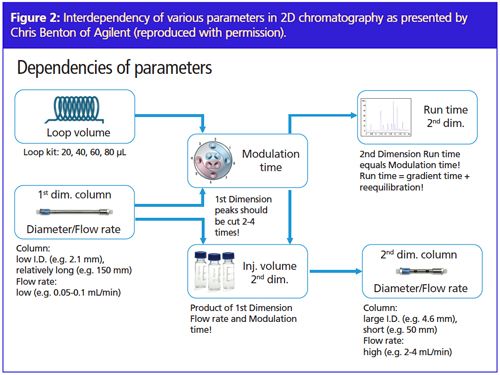
The second talk from Guy Wilson from Waters was titled, “SFC Comes of Age - A Review of How SFC is Solving Chromatographic Challenges Today” and discussed the importance of mobile phase density in SFC and how this could be modified to impact analyte elution working either isochemically (constant temperature and varying pressure) or isobarically (constant pressure and varying temperature). In practice, however, gradients using methanol are typically used to analyze analytes of log P values ranging from 10 (highly hydrophobic) to -5 (very hydrophilic). He exemplified the versatility of this technique through the analysis of lipids in porcine brain extract (covering a large range of polarities), dried blood spot analysis (free fatty acids), fat and water soluble vitamins, hydrophilic pharmaceuticals and biological fluids observed in sports doping, and related polar metabolites. He also described how scientists at AstraZeneca in Mölndal (Gothenburg, Sweden) are using analytical SFC for scouting conditions on the preparative scale, highlighting the improvements in cycle time, solvent consumption, and milder sample evaporation conditions compared to traditional normal-phase LC approaches.
The final sponsor presentation was provided by Chris Benton of Agilent Technologies: “What Has 2D-LC Ever Done For Us?” He opened with a review on peak capacities achievable with single, combined, and hyphenated chromatographic methods, and the need for separation mechanism orthogonality to maximize peak capacity in two or more dimensions. Chris then went on to describe the various modes of multidimensional chromatography, that is, heart-cutting, multiple heart-cutting, and comprehensive with MS detection for complex biological separations. He also described the coupling of achiral and chiral columns for the resolution of ibuprofen chiral and achiral impurities. The use of a 12-port loop multiple heart-cutting valve was described and was shown to negate the need for a fast second dimension because multiple fractions can be parked, for example, for impurity profiling activities. These parked peaks can therefore be analyzed with different gradient profiles (“shift” gradients) in the second dimension if required. Two-dimensional chromatography is also more amenable to analytes in complex food or environmental matrices - for example, samples prepared by a QuEChERS (Quick Easy Cheap Effective Rugged Safe) approach - because much of the matrix is removed in the first dimension. This is particularly beneficial where MS detection is employed.
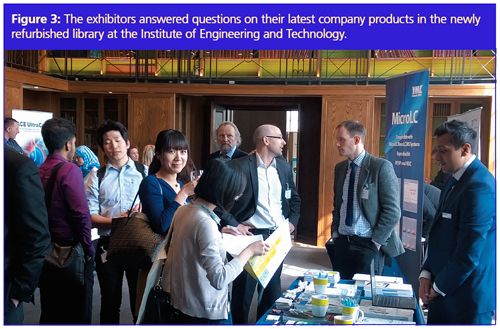
The vendors were also present in the recently refurbished Institute library to discuss their latest product ranges and offer technical advice (Figure 3). Table 1 summarizes the vendors that sponsored the event.
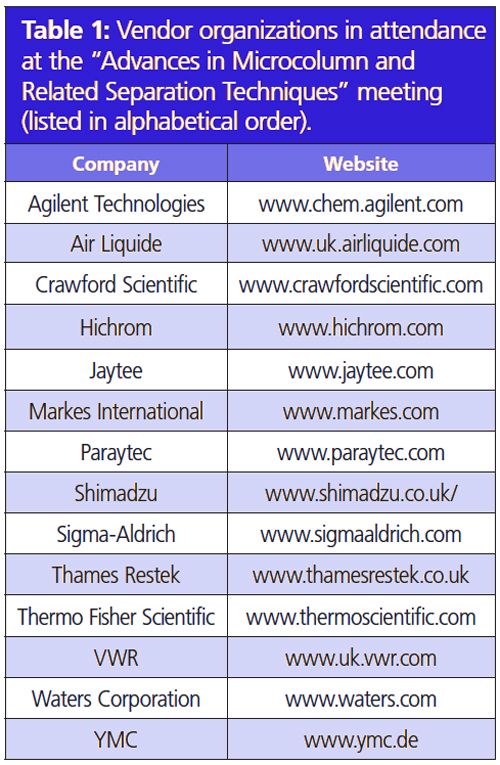
The first session after lunch was chaired by another former President of The Chromatographic Society (1994–1996) - Mike Cooke. This session focused on GC, and, like the morning session before, included world-renowned researchers. The first lecture in the session was provided by Martin Medal winner Pat Sandra (University of Ghent, Belgium) who discussed “Recent Advances in Automation of Sample Preparation and Injection in Capillary GC”. Pat started by discussing the throughput-productivity-resolution triangle. As theoretical plate counts are easily calculated by dividing the column length by the capillary internal diameter, it is possible to determine conditions that meet these three areas, for example, high resolution chromatography requires ~1 million theoretical plates, which could be generated using GC–GC in approximately 2 h. He then described Giddings’s statistical overlap theory and calculated that for a 95% resolution probability of all components in a sample, 66 million theoretical plates are required. These values are obviously only achievable with multidimensional GC approaches and this was illustrated with examples from the metabolomics field. Pat then described a paper on metabolomics profiling that suggested that many peaks were actually thermal degradants (8). There are many parameters that could be optimized to reduce thermal degradation effects (which are a combination of column temperature and residence time) such as injection type (PTV, cool-on-column), inlet liner (glass wool is prone to formation of thermal degradants), and absorbent. Pat showed that correct selection of these can lead to the analysis of many thermolabile analytes, such as torcetrapib and nefedipine, without issue.
In the second part of his presentation, Pat described various approaches to increase analytical productivity through sample preparation using automated liner exchange on dirty QuEChERS samples. This can provide highly reproducible retention times that are not possible without liner exchange. He also highlighted numerous other automated sample preparation approaches, including microwave, ultrasonic, evaporative concentration, and centrifugation. Many of these approaches were combined in his final example for the analysis of fatty acid methyl esters, triglycerides, and sugars found in chocolate. He concluded that he felt GC was a mature technique but that it also needed the users to be more mature in how they approach their GC separations!
The next presentation in the session was provided by Jubilee Medal winner, Tom Lynch, (BP, Runcorn, UK), who posed the question “Just How Flexible can a GC Capillary Column be?”. Tom began by discussing historical aspects of GC and in particular the work of Dennis Desty (one of the original Chromatographic Society founders, Desty worked at BP and was one of the early developers of glass capillary columns). He moved on to describe some of the analytical challenges his team face at BP, where GC is the principal analytical technique. He stated that whatever the challenge is, high resolution chromatography is required and can be achieved through a number of options including sample preparation, sample introduction, and detection approach, in addition to correct GC phase and column dimensions. He ably demonstrated this and the tools available to his group in an example differentiating ethanol from biofuel dilution in lubricant samples from field trials.
Tom presented additional examples, including one taken from the world of motorsport where the team requested assistance to identify the source of debris found in an oil filter after a race and pyrolysis-GC was used to solve the issue. Another example involved identifying sludges formed in process plants and engines, which required a raft of techniques including thermal desorption and pyrolysisâGC–MS to elucidate. He closed his talk by discussing the variety of mass spectrometers that can be hyphenated to GC and what advantages each one brings. He concluded by saying that advances and application of GC in the petrochemical industry will be realized with the hyphenation of GC with more powerful mass spectrometers in the future.
The final presentation in this session was delivered by Kevin van Geem (University of Ghent) titled “Chemical Engineering Meets Comprehensive 2D GC: Love at First Sight”. He began by discussing the limitations of 1D chromatography for characterizing complex oil samples. He moved quickly on to GC×GC and demonstrated that this offered a great option to characterize samples such as kerosene, especially when coupled with MS detection such as time-of-flight (TOF)-MS. Flame ionization detectors (FID) and MS detectors offer complementary information and allow fractions of 2D-chromatograms to be characterized in regions with common structural moieties, such as paraffins and napthenes.
Kevin moved on to discuss his group’s work in more detail using soft ionization MS and linked it with micropyrolysis for the analysis of extremely heavy oil fractions and detection of trace sulphur and nitrogen impurities (the latter using sulphur chemiluminescence and nitrogen chemiluminescence detection) in steamâcracking petroleum samples. These latter detectors are used because FID detectors exhibit response bias for Sâ and N-containing analytes. By using of all these detectors (on multiple instrument configurations) and through the use of internal standards, the resolution and quantification of many different types of fractions of differing polarity and chemical composition could be analyzed. He then showed how these systems were being applied in a real industrial environment and concluded that GC×GC could be very versatile for the analysis of heavy petroleum fractions, but only those of C60 or less. He brought his presentation to a close by describing the use of Fourier-transform ion cyclotron resonance (FT-ICR)-MS and the possibilities that this may bring for even higher resolution analyses of these types of samples.
The final session of the afternoon was chaired by Keith Bartle (President of The Chromatographic Society 1998–2000) and focused on other key separation technologies. The first presentation in this session was delivered by Frederic Lynen (University of Ghent) on “Contemporary Packed Column Capillary Chromatography”. He opened his presentation by comparing CEC and LC, noting that chromatographic efficiency in LC is limited by column pressure drop, which is primarily dependent on column length and particle size. In CEC, efficiency is governed by applied voltage and benefits from highly reduced eddy diffusion as a result of the flat flow profile produced under electroosmotic conditions (CEC suffers no pressure constraints). He described how very high chromatographic efficiencies of ~300k in 50 µm capillaries packed with 1-µm particles could be achieved, but how this was currently unachievable because of the high field strengths required and a lack of commercial power sources.
Interestingly, a van Deemter analysis for neutral test probes in both LC and CEC using the same mobile and stationary phases showed unexpectedly better performance of HPLC over CEC (plate heights of 8 µm and 10 µm, respectively at their optimal flow rates). Retention was also higher in LC than CEC, which was greater than that predicted from differences in phase ratio alone. However, as is often cited, van Deemter plots do not sufficiently describe the pressure restrictions in LC-driven separations and therefore a kinetic plot (KP) approach was also described for CEC separations. However, even when this treatment was undertaken, LC separations with a conventional 400 bar system still outperformed CEC.
Frederic presented his thoughts on the reduced retention observed in CEC compared to LC. He suggested that this could be a result of Joule heating effects and demonstrated that moving from a column temperature of 10 oC to 45 oC resulted in a threefold reduction in retention time - temperatures of 70–90 oC should be used for this factor of reduction in retention. Van’t Hoff plots (ln k versus 1/T) demonstrated linearity, but measurement of current as a function of applied voltage showed slight curvature, suggesting Joule heating was the reason for higher than anticipated drops in retention. Further interesting data was presented as CEC van Deemter and kinetic plots at different temperatures were constructed. The best chromatographic performance was observed at the lowest temperature, and then 35 oC and 45 oC. Room temperature was shown to provide the worst performance but Frederic could not offer an explanation for this observation. He concluded this part of his presentation with a discussion on the potential of subâµm particles with very high voltage systems (120 kV!), which could potentially generate 1 million theoretical plates in 21 min!
Frederic then considered the use of hydrophilic interaction CEC (HICEC) on bare silica particles. The HICEC mechanism performs analogously to HILIC but does not deliver the anticipated efficiency or speed improvements over HILIC. Frederic described potential application areas for this technology including nitroaromatic bomb residues and polar polymer analysis.
The last part of his presentation focused on the potential of open tubular (wall coated) CEC using a monolithic coated PS-DVB-VSA (polystyrene-divinylbenzene-vinylsulphonic acid) polymer. He discussed the impact of varying monolith preparation parameters such as polymerization time and monomer ratios on chromatographic efficiency, illustrating a maximum efficiency of 70k for a 25 cm × 10-µm i.d. capillary for neutral paraben test probes. As might be anticipated, increasing temperature on these columns generally provided better efficiency and shorter analysis times, but, interestingly, a lower operating temperature of 15 oC again gave the best predicted performance for chromatographic efficiency when described through kinetic plot analysis. Further information on this work can be found in references (9) and (10).
It would have been remiss if the reâemerging topic of supercritical fluid chromatography was not discussed at this meeting and duly Jean-Luc Veuthey (University of Geneva, Switzerland) presented “New Insights in SFC and SFC–MS”. Jean-Luc opened his presentation by reflecting on the benefits of SFC in terms of speed of analysis, resolution, and high sensitivity attributable to the low viscosity, high density, high diffusivity mobile phase. He also described the range of analyte polarities amenable to this technique (Figure 4) and explained that on new lowâdispersion SFC systems, 100 × 3.0-mm, 1.7-µm columns exhibit the best compromise between retention and efficiency (11).

Jean-Luc presented practical examples to illustrate comparable performance for HILIC and SFC separations of polar bases (12) and how the addition of ammonium formate to the sample vial (13) (or in the mobile phase) improved peak shapes for basic analytes (except when using a 4-ethylpyridine column). He also described the use of superficially porous columns in SFC and, like LC, these show similar chromatographic performance to fully porous 1.7-µm particles.
Moving on to SFC–MS, Jean-Luc described the application of this approach to doping control analysis, which was shown to provide complementary orthogonality to UHPLC–MS(/MS) and generally more tolerant to difficult matrices like urine than UHPLC (although dilution was required). This was exemplified through the analysis of 101 doping agents including steroids (14,15). The use of SFC–MS for the analysis of natural products (120 analytes) of varying polarity was discussed and again its complementary nature to reversedâphase UHPLC–MS was demonstrated. SFC was a better choice in the resolution of isomers, or where normal-phase extraction solvents like dichloromethane (DCM) were required. He ended his presentation by discussing the potential of 2D chromatography combining SFC and LC (the first dimension being analyte-dependent) and also the possibility of interfacing with ion-mobility MS to provide further spatial resolution.
The last presentation of the day was provided by former Chromatographic Society Vice-President, Jubilee Medal (2006) and 2016 Martin Medal recipient Peter Myers (University of Liverpool, UK) on “The Future of Capillary Separation Technologies”. As ever, Peter’s presentation was energetic and engaging and touched on his group’s research as well as his thoughts on the future of separation science. He started his presentation by discussing his group’s work on the development of monodispersed silica and sphere-on-sphere particles, which could have applicability for biomolecule analysis because of their fast mass transfer (16).
Peter discussed “Chemchip” point-ofâcare diagnostics, which use chip-based separation processes with CCD detection and have potential for plug-and-play separation systems. He also discussed a DNA diagnostic chip that is in development for detecting and determining pathogenic germs based on the direct detection of organism-specific nucleic acid sequences (https://www.gatc-biotech.com/en/science/research-development/sepsis-chip.html). Peter also described a solidâphase microextraction cartridge where the cartridge is in the barrel of the syringe and can be integrated as part of an automated sample preparation approach. He suggested that these types of short columns could be integrated into a “HPLC in a shoebox” and controlled via a cheap Raspberry Pi computer.
The last area Peter touched on was a detection approach for the detection of gases and vapours based on dynamic switching of liquid crystals. While these have been used most recently as stationary phases in GC, in his work, liquid crystals were bonded on to a gas permeable membrane using a high frequency electric field to switch the crystal polarity. Analytes partitioned onto the liquid crystals and different patterns were generated on an oscilloscope, which could be deconvoluted using a statistical treatment to give an analyte-specific response.
As the final act of The Chromatographic Society’s first meeting of its Diamond jubilee year, Alan Handley (past President of The Chromatographic Society) brought the meeting to a close by thanking the vendors and delegates. He asked those present to support the Society and its charitable endeavours by attending future meetings organized by The Chromatographic Society. The meeting received effusive feedback from all attendees and was prominent on social media (see @chromsoc on Twitter). The venue facilities were excellent and proved that ChromSoc meetings in the capital can still be very popular.
References
- J.M. Davis and J.C. Giddings Anal. Chem.55, 418 (1983).
- B. Wouters et al., Lab Chip15, 4415 (2015).
- H.G. Gika et al., J. Sep. Sci.32, 1598 (2008).
- W. Chen et al., J. Chromatogr. A1414, 147 (2015).
- G. Desmet et al., Anal. Chem. 87, 7382 (2015).
- C. West et al., J. Chromatogr. A 1409, 241 (2015).
- W. Boughtflower et al., J. Chromatogr. A1218, 3711 (2011).
- G. Siuzdak et al., Anal. Chem.87, 10935 (2015).
- S. De Smet and F. Lynen, J. Chromatogr. A1355, 261 (2014).
- S. De Smet and F. Lynen, J. Chromatogr. A1404, 81 (2015).
- A. Grand-Guillaume Perrenoud et al., J. Chromatogr. A 1314, 288 (2013).
- A. Periat et al., J. Sep. Sci. 36, 3141 (2013).
- V. Desfontaine et al., J. Chromatogr. A1438, 244 (2016).
- L. Novakova et al., Anal. Chim. Acta853, 637 (2015).
- L. Novakova et al., Anal. Chim. Acta915, 102 (2016).
- R. Hayes et al., Analyst 139, 56 (2014).
Paul Ferguson is currently the President of The Chromatographic Society but previously served as Vice-President for the Society (2009–2014) and in this role was Chair of the Medals Committee conferring the Martin Gold and Jubilee Medals. He has also organized or co-organized several successful symposia for the Society since 2007 and is involved with the organization of two meetings as part of the Society’s Diamond Jubilee celebrations in 2016.
W. John Lough (University of Sunderland) is a longstanding member of the Executive Committee of The Chromatographic Society. His activities for the Society have included organizing or co-organizing 21 national 1- or 2-day symposia, chairing the 8th International on Chiral Discrimination (1996) and serving as Editor of the Chromatographic Society Bulletin (1992–1997), Treasurer (2000–2006), President (2007–2009), contributing editor to Chromatography Today (2007–2016), Secretary of the International Symposium on Chromatography Permanent Scientific Committee (2010–2014), and editor of The Chromatographic Society Diamond Jubilee Supplement (2016).
E-mail: chromsoc@meetingmakers.co.uk
Website: www.chromsoc.com
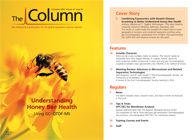
















Fundamentals of Benchtop GC–MS Data Analysis and Terminology
April 5th 2025In this installment, we will review the fundamental terminology and data analysis principles in benchtop GC–MS. We will compare the three modes of analysis—full scan, extracted ion chromatograms, and selected ion monitoring—and see how each is used for quantitative and quantitative analysis.
Characterizing Plant Polysaccharides Using Size-Exclusion Chromatography
April 4th 2025With green chemistry becoming more standardized, Leena Pitkänen of Aalto University analyzed how useful size-exclusion chromatography (SEC) and asymmetric flow field-flow fractionation (AF4) could be in characterizing plant polysaccharides.
This information is supplementary to the article “Accelerating Monoclonal Antibody Quality Control: The Role of LC–MS in Upstream Bioprocessing”, which was published in the May 2025 issue of Current Trends in Mass Spectrometry.
Fundamentals of Benchtop GC–MS Data Analysis and Terminology
April 5th 2025In this installment, we will review the fundamental terminology and data analysis principles in benchtop GC–MS. We will compare the three modes of analysis—full scan, extracted ion chromatograms, and selected ion monitoring—and see how each is used for quantitative and quantitative analysis.
Characterizing Plant Polysaccharides Using Size-Exclusion Chromatography
April 4th 2025With green chemistry becoming more standardized, Leena Pitkänen of Aalto University analyzed how useful size-exclusion chromatography (SEC) and asymmetric flow field-flow fractionation (AF4) could be in characterizing plant polysaccharides.
This information is supplementary to the article “Accelerating Monoclonal Antibody Quality Control: The Role of LC–MS in Upstream Bioprocessing”, which was published in the May 2025 issue of Current Trends in Mass Spectrometry.
